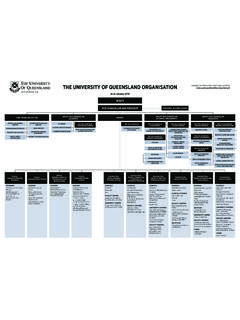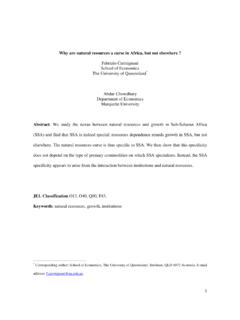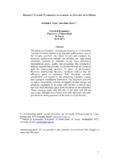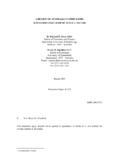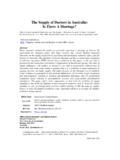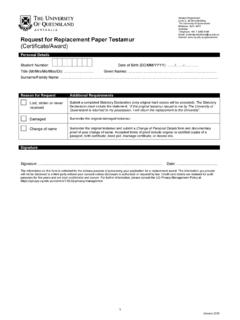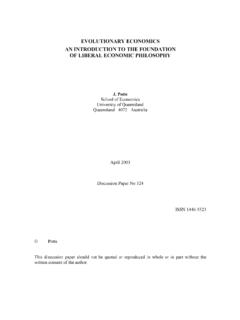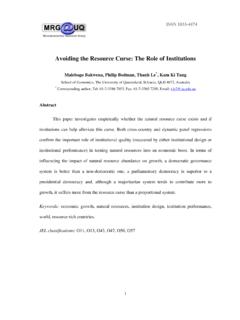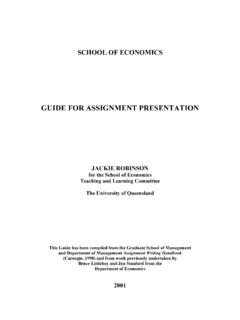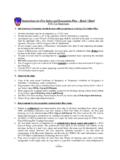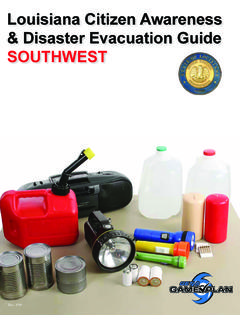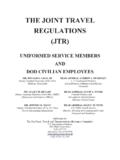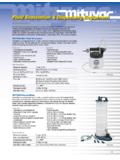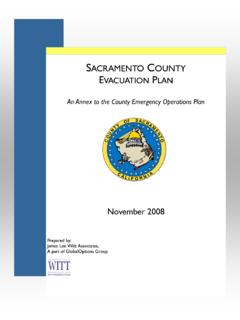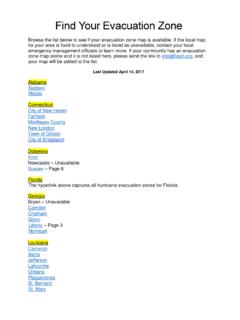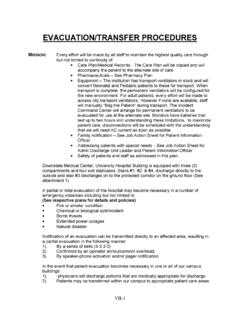Transcription of Fire and Emergency Evacuation Procedures - uq.edu.au
1 THE UNIVERSITY OF QUEENSLAND FIRE AND Emergency Evacuation Procedures Page 1 Fire and Emergency Evacuation Procedures Overview 1. Introduction These guidelines are intended to establish the Procedures to be adopted in the event of any Emergency which may require partial or total Evacuation of buildings within the University. Evacuation from buildings may be necessary as the result of fire, explosion, chemical leak, structural fault, equipment failure or bomb threat. These guidelines have been prepared principally for fire emergencies, but they are suitable for use in other emergencies.
2 These Procedures have been developed for use in all University buildings, other than those occupied by Medical and Dental departments for which effective Procedures have already been instituted by the hospital with which the department is associated. However, adjustments may be required for sites other than St Lucia, particularly in relation to the Emergency call-out phone numbers. Specific instructions, based on these guidelines, should be prepared for each University building. The features of a particular building, its occupants or fire alarm system may require modification of these Procedures .
3 Enquiries in relation to these Procedures should be made to the Occupational Health and Safety Unit (telephone 3365 2365). In order to avoid delay, confusion and possible injury in the event of an Emergency , it is essential that Evacuation Procedures and organisational arrangements are well understood and regularly practised by University employees. This is a requirement of the Queensland Fire Service Act. Description 2. Purpose The purpose of the Emergency Evacuation Procedures and associated organisation is to provide for: Fire and hazard prevention; Safe and orderly Evacuation of people from the building in an Emergency ; Early control of the fire or Emergency ; and Speedy resumption of duties once the Emergency is brought under control.
4 3. Emergency Organisation The system of coordination for Emergency Evacuation Procedures is outlined below: The Emergency Co-ordinator (for the University site). A Building Warden and Deputy for each building. Floor or Area Wardens and Deputies for each building. Emergency Coordinator Appointment: THE UNIVERSITY OF QUEENSLAND FIRE AND Emergency Evacuation Procedures Page 2 The Emergency Coordinator at St Lucia Campus is the Manager of Security Services. The Deputy Emergency Coordinator at St Lucia campus is the Fire Officer.
5 In the absence of these officers, the Security Shift Superintendent will designate a specific person to undertake the role of Emergency Coordinator. The Emergency Coordinator at Gatton Campus is the Security Supervisor or his nominee. The Manager of Security Services, St Lucia, will ensure that Emergency co-ordinators are appointed for sites other than those covered by Security Section at St Lucia or by the Security Supervisor at Gatton Campus. At sites other than St Lucia, staff should be advised by their supervisor of the Emergency coordinator for the site.
6 Responsibilities: The Emergency Coordinator shall be responsible for overall coordination of actions in connection with Emergency Evacuation Procedures . He/she is responsible for: Before Fire or Emergency : o Ensuring that personnel responsible for Emergency Evacuation are aware of their responsibilities. In the case of Fire or Emergency : o Checking that the alarm has been relayed to the Fire Service. o Ensuring that designated duties are correctly and promptly carried out. o Acting as liaison officer with Police, Fire Service and other Emergency services.
7 O Ensuring that all Emergency service personnel are directed to the building involved in the Emergency . o Liaison with the Building Warden for the building involved in the fire or Emergency . o Advising staff and students when it is safe to re-enter the building. Building Wardens Appointment: A Building Warden and deputies (it is usually necessary to appoint more than one deputy building warden to ensure continuous availability) should be appointed for each building. If the building is occupied by only one department, the head of that department should make this appointment.
8 Where more than one department occupies a building, the appointment should be made by the appropriate Executive Dean or Executive Deans in consultation. The Building Warden and deputies should be physically fit, mature and responsible members of staff with personalities that will give confidence in an Emergency . Their normal work location should preferably be on or close to the ground floor and their duties should not require frequent absences from the building. The Building Warden should ensure that either the Building Warden or deputy is available at all times during normal working hours.
9 THE UNIVERSITY OF QUEENSLAND FIRE AND Emergency Evacuation Procedures Page 3 Responsibility: The Building Warden, during Emergency situations, will be in control of the occupants of the whole building until the arrival of the Fire Service Senior Officer. It is the Building Warden's responsibility to: Before Fire or Emergency : o Assist in training of Emergency personnel under their command. o Designate an assembly area (or areas) for the building. Occupants of the building should be directed to assemble in this area when required to evacuate the building in an Emergency .
10 This will facilitate checking that all occupants are safe and enable speedy return to the building when the "all clear" is given. o Ensure that on each floor, or in each area, a current list of Floor and Area Wardens (and telephone numbers) is displayed, together with an Emergency floor plan. The Emergency floor plan should show all rooms, exits, assembly area to be used in case of fire or Emergency , fire alarms, extinguishers, fire hose reels and special Emergency equipment. o Ensure that all staff in the building are given instruction in relation to: Evacuation Procedures ; means of escape from the building and location of assembly areas; the location and operation of fire alarms; and the location and operation of fire extinguishers or other Emergency equipment required in the building.
